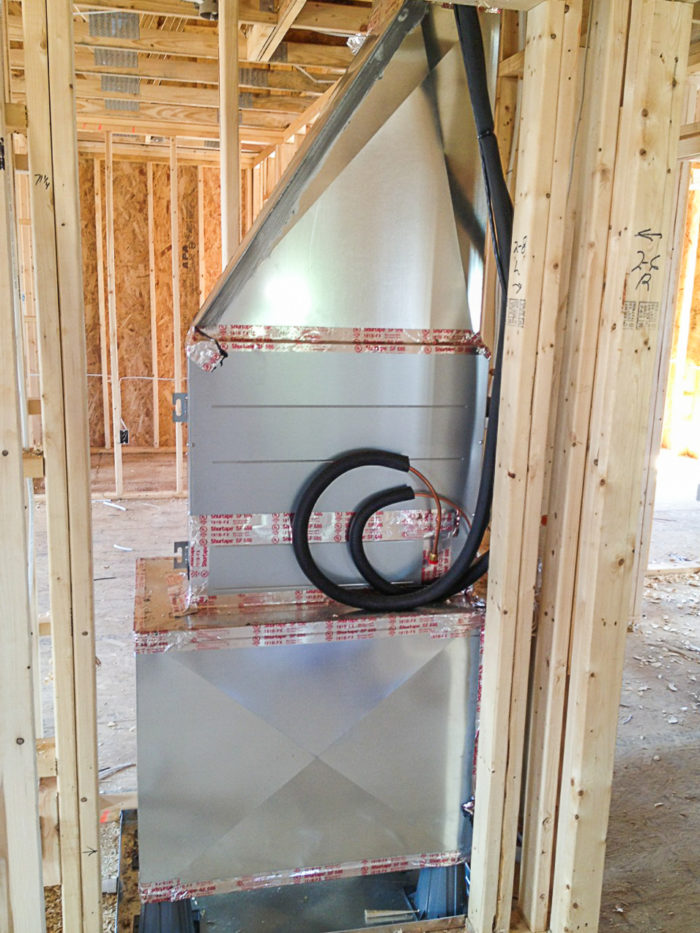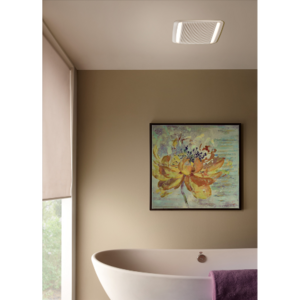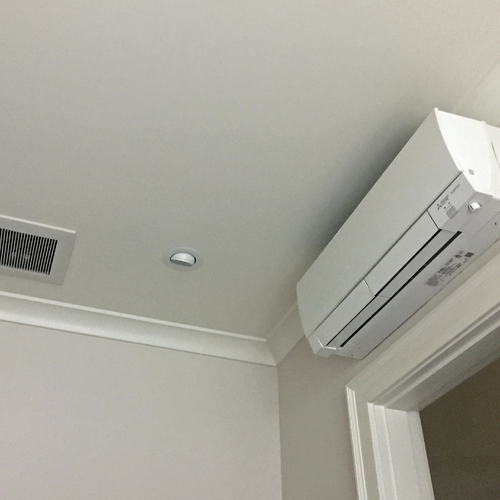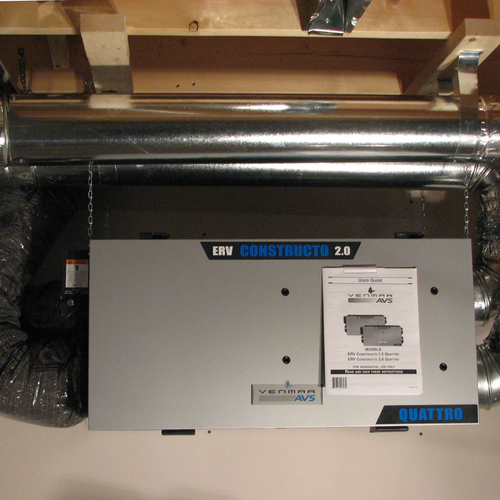
Image Credit: John Semmelback
Debra’s new house in southwestern Virginia will be a one-story design of 1,344 square feet with half the space devoted to a single, open room and the remaining area divided into two bedrooms, two baths, and a utility room. The main source of heat will be in the open room, and in the absence of a conventional forced air heating system, Debra’s quandary is how to distribute the heat evenly.
Heating loads for this Climate Zone 4A house are relatively modest — about 14,000 Btu per hour. Between small baseboard heaters and leaving doors open, the bathrooms and utility room should have enough heat. It’s getting heat to the bedrooms that’s looking more problematic.
In a post at the Q&A forum, Debra wonders whether low-output bathroom fans can be used for heat distribution.
“We are interested in using a couple of Panasonic bathroom fans to send warm air from the main room to each bedroom, using 6-inch metal ducts going straight about 15 feet (within the building envelope),” she writes. “The fans have adjustable speeds, and at the highest speed of 150 cfm they could change over the air in each bedroom in just 7 minutes (which might be too much).
“Seems like that could do a fairly decent job of evening out the heat between the main room and the bedrooms,” she continues. “I don’t care if the bedrooms are a few degrees cooler, though.”
This simplified heat distribution system would let Debra skip baseboard heaters and programmable thermostats for the bedrooms. But will it work?
That’s the topic for this Q&A Spotlight.
Sorry, the plan won’t work
GBA senior editor Martin Holladay gives Debra two reasons why this is not a good idea.
“The first relevant factor is the specific heat of…
Weekly Newsletter
Get building science and energy efficiency advice, plus special offers, in your inbox.

This article is only available to GBA Prime Members
Sign up for a free trial and get instant access to this article as well as GBA’s complete library of premium articles and construction details.
Start Free TrialAlready a member? Log in















10 Comments
Active systems
Carl's system sounds like it works for Carl - who like many denizens of GBA has an intense interest in his house. Most people don't. If the only way to effectively equalize the temperatures is through an active system that needs the inhabitants to monkey with the controls depending on who is home or what the weather is like, it generally won't get used.
Response to Malcolm Taylor
Malcolm,
There are lots of off-grid houses and active solar houses from the 1970s that have secret valves, secret dampers, and secret switches. The owner-builder makes all kind of seasonal adjustments, and knows exactly what to do.
When the owner-builder has to go away on a business trip, he has to show his spouse a three-ring binder full of instructions. "If the monitor on the living room wall shows 17.4, go to the basement and open the valve with the red handle near the south window."
If you've got a house with this kind of manual, your house is too complicated. Ask me how I know.
My House
Malcom - My house doesn't require any special actions - if the person living here wanted to leave the fan in the on position - it would distribute air into the bedrooms whenever the mini split turns on. I choose to keep it turned off as I don't need it when the doors are open. That is the only option available - no detailed operation instructions other than how to use the thermostats, which can be set to auto switchover from heat to cooling. I choose to fiddle with things, but if someone in this house chose to never touch a control, the house would operate just fine, albeit probably use a bit more energy that I choose to.
Carl
"I choose to fiddle with things, but if someone in this house chose to never touch a control, the house would operate just fine"
A perfect combination then. Room for the enthusiast and the laymen too. I took you description as describing what was necessary, as opposed to what you do because you enjoy tinkering.
Martin's "secret valves" reminds me not only of those early 70's house though, but also the new smart-function enabled ones. The only difference is you can tinker at a distance.
Too little emphasis on the building enclosure
Bath fans are one side of the heat transfer battle that takes place in indirectly-heated parts of the house: how fast does the heat make its way there versus how fast does the heat get lost to the outside. (Obviously applicable to cooling and dehumidification energy - I'm writing from the North.) Slow heat loss to the outside and the bedrooms could easily stay at 60 deg and above. I think humidity is a bigger deal, so a great building enclosure AND some air circulation into those rooms sounds like a winner.
As an aside, in our -11 deg design load climate we have homes with just a mini-split in the living room. A ventilation system that also circulates air within the house delivers about 20 cfm to the bedrooms, and they stay within 3 degrees of the main body of the house.
Another way to look at it.
I'm almost afraid to do the math here as there is a good chance of me messing it up somewhere along the line, but here goes.
Debra's house sounds very similar to the one we are designing in terms of heat load. Both are in zone 4 and both have a peak load of about 10 btu/hr per square foot of living space. The heat load calculations on our house (passive house software) also show an across the year average head load of only about 1 btu/hr/sq.ft.
Using Martin's equation a 100 cfm fan can move 108 btu/hr of heat with a 1 degree delta T. So on a temperate day a 100 cfm fan should be able to keep a 100 sq. ft. room in our zone 4 houses within 1 degree of the room it is drawing air from. On the coldest day of the year that same room would be 9 degrees cooler. This of course assumes a lot of things including that the bedrooms have the same average heat loss as the rest of the house.
If one uses an efficient, 100 cfm fan at say 10 cfm/watt and runs it continuously it will consume the equivalent energy of about 35 btus/hr. Assuming a COP of 2.5, it costs the equivalent of 45 btus/hr for the heat pump to produce 108 btu/hr of heat. So conceivably the total power consumption would be 80 btus/hr for 108 btus/hr of heat. An inexpensive, small flush mounted electric heater could produce that same heat using the equivalent of 108 btus/hr. That difference of 28 btus/hr would only cost $7 per year at our electric rates of $0.10/kwh. It seems like the simpler system would function better at a lower installed cost and a very small up-charge in operating cost.
We are looking at using the horizontal ducted units in our house based on Dana's recommendations, working through cost and ducting now. It is hard to get anyone to do the ducting design. The HVAC contractors I have talked to just want to come to the job site after the house is built.
Debra doesn't mention cooling...
In Z4A Virgina, how does this house not have an actionable cooling load? You can sometimes get away with indirect heat distribution in cold (heat-only) climates because folks are more tolerant or even prefer lower temps in bedrooms. But when you have a cooling load, especially in bedrooms, you gotta deliver supply air to where the load is. A ducted mini would seem to be the best solution, based on the information provided.
With metal ducts, length isn't much of an issue, which is why it's misleading to say a ducted mini can only handle x feet of duct. It's the elbows and other fittings that disrupt airflow. The Fujitsu ducted mini can handle a whole house with a carefully thought-out layout.
Among the small models (1.5 tons and under), Daiken has the least powerful blower (0.12 IWC), followed by Mitsubishi (0.20 IWC), whereas the Fujitsu can handle 0.35 IWC external static, more than enough for a well-designed metal duct system.
For a hallway drop ceiling scenario, my preference is a fabricated 'extended plenum' reduction trunk with curved branch take-offs, where the branch duct serves as the boot for over-the-door supply registers. Thus no elbows. On the return side, in lieu of factory filter, I specify an over-sized filter box at the butt end of the blower with filter sized to about 175 cfm/ft2.
I find the biggest challenge is meeting the required left-side service access clearance. Most halls aren't wide enough for unit width plus side clearance. However, if there's an adjacent laundry or closet on the left side of the hall, you can shift the unit all the way to that side and put a drop ceiling and access panel on the immediate other side of the wall.
No local Fujitsu contractor
Our home (the one under discussion here) will be located in the mountains of SW Virginia, which is considerably cooler than most of the rest of the state. But the summer humidity levels still make some amount of AC desirable (and/or a small dehumidifier - though I hate the noise level of those).
Our sensible cooling load is about 9600 and latent cooling load around 2300 (depending on how much ventilation we are using). I usually tolerate the heat relatively OK, but hate the sticky humidity levels.
Unfortunately, there are no authorized Fujitsu contractors anywhere near us, as we are far from any cities. So that doesn't look like a feasible option.
then consider the obvious...
I agree 100% with Peter Yost's sentiment, that not wanting to install HVAC in a sealed crawl is "an irrational bias based on our history of thoroughly confused and dysfunctional vented crawls and attics." In fact, to the extent that your crawl could still be at risk for mildew or mold, installing a conventional ducted system down there, with a small supply vent, would further reduce the risk.
Regarding Fujitsu... unless Fujitsu has changed it's policy, any contractor can sell and install Fujitsu systems. The 'authorized contractor' designation is simply a way to steer prospective customers to contractors who make a commitment.
David's Comments
David,
We are planning to use Fujitsu horizontal ducted units because they are a little more efficient, but mainly because of the stronger distribution fans. I'm having a hard time figuring out where to position the units and how to run the ducting before the house is built (when I can still make adjustments to the framing cheaply). Your comments on placement and access were helpful.
Since I can't seem to find an HVAC contractor who wants to engage on the topic of planning the layout and ducting, would you be able to point me to information available to help me plan the system myself? Placement of the units will mostly be above lowered ceilings in closet areas with the ducting running either in conditioned attic space, between floor joists, or in wall cavities. The conditioned attic area is shallow space between the lower and upper cords of scissor trusses. The top cord with a 5:12 pitch and the lower with a 2.5:12 pitch. I have from 6" to about 30" to work with up there. The floor joists are 11 1/2" I-joists.
Any pointers or recommended sources of information would be appreciated, from David or from others.
Log in or become a member to post a comment.
Sign up Log in